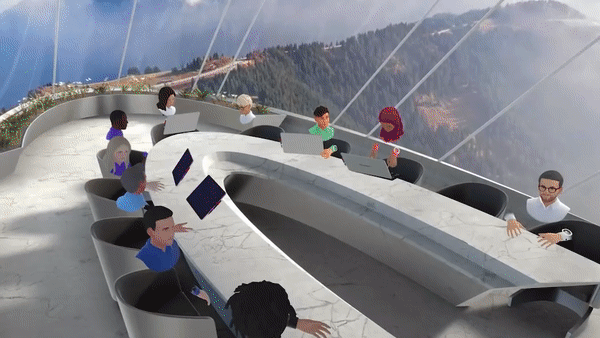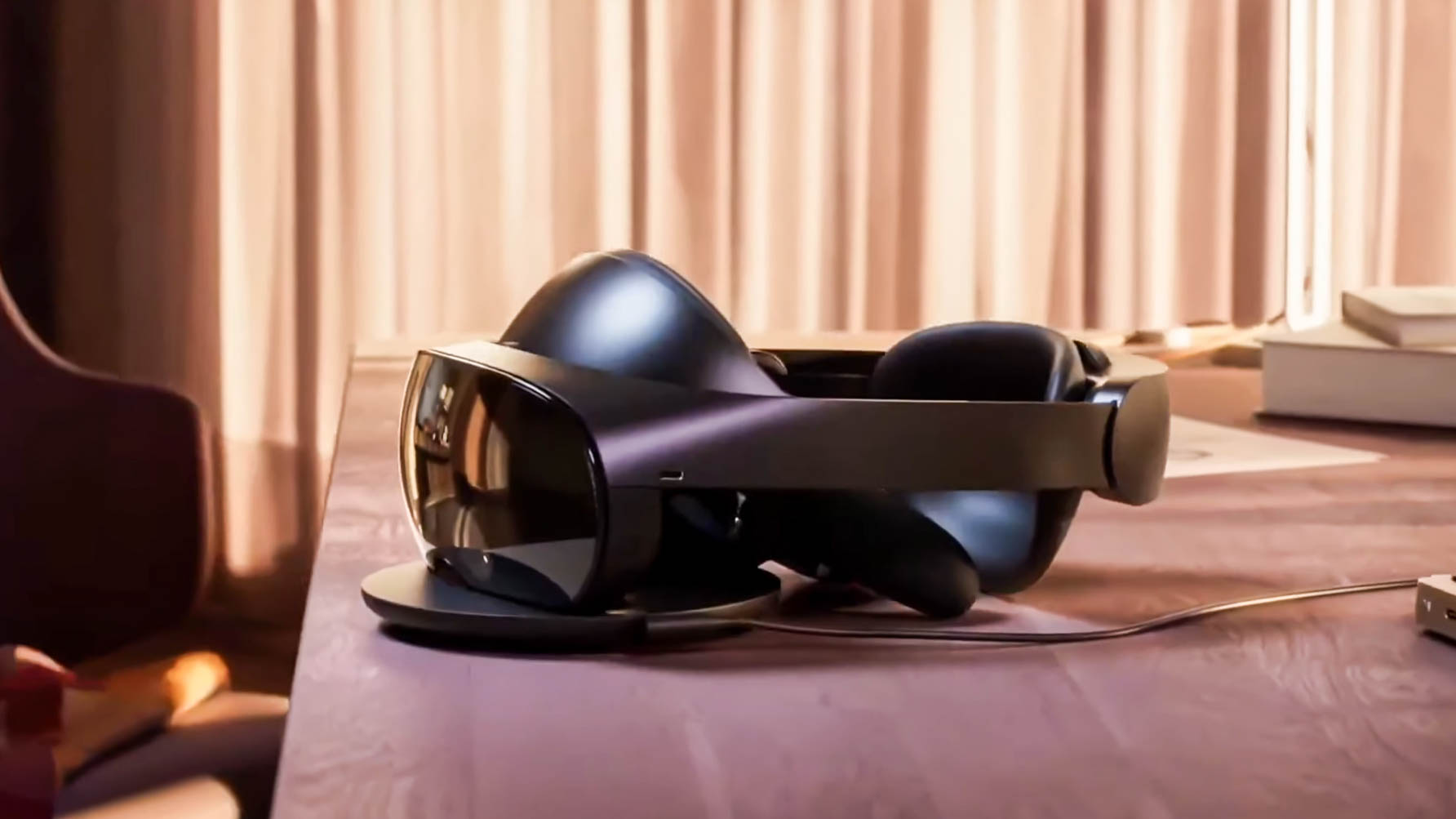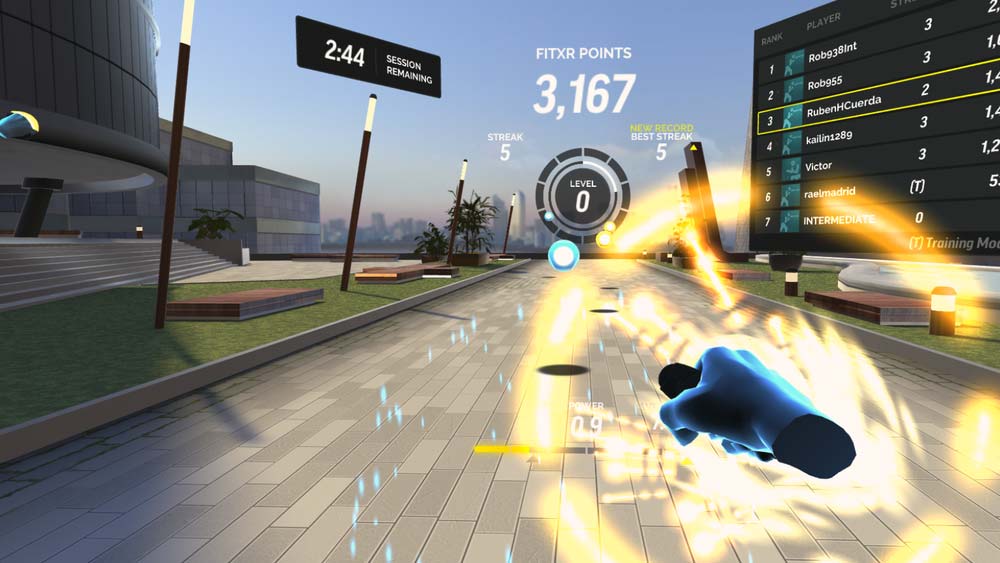I spent a day in VR with my favorite coworker and ended up hating him — here’s why
We put Meta’s VR workplace ambitions to the test

“Hate?! That’s such a strong word!” you may be thinking. You’re right. Perhaps miffed is a more fitting word Laptop Mag Editor Darragh Murphy (an England resident) would use to describe our post-day-in-VR sentiments toward each other.
Strapping Meta Quest 2 VR headsets (formerly known as the Oculus Quest 2), Darragh and I kicked off our day-in-VR session with ferocious boxing for our morning workout, followed by a typical Laptop Mag workflow in a VR office before concluding the day with drinks at a simulated bar. Sounds exciting, but it ended up being a taxing experience.
It’s not Darragh, who’s such a dear, who irked my nerves per se. And it wasn’t me — as a person — that drove him up the wall either. It’s just that the VR world is a dystopian realm that is bereft of authentic human facial expression (and other micromotor movements that foster rapport and connection). Consequently, we were left feeling disconnected from each other. However, unrealistic, stony avatars weren’t the only culprits behind the rupture of our professional relationship (more on that later).
What made us want to spend a day in VR in the first place? Well, in late 2021, Meta officially revealed its ambitions of erecting its own interpretation of “the metaverse,” which CEO Mark Zuckerberg described as “the next frontier in connecting with people.”

From my perspective, Meta envisions itself as one day becoming the Google of metaverse platforms. In other words, yes, there will be alternatives to choose from, but Meta wants to snatch the lion’s share of the market, inviting a new era where the whole world is strapping on VR headsets for play, work, social connections, enterprise ambitions, and more.
Could Meta eventually prove us all wrong and materialize its metaverse dreams into reality? It’s possible, but I’d argue that it’s improbable. As I breakdown my experience spending a day in VR with Darragh, you’ll see why.
Meta’s Horizon Workrooms app drove us mad
When Darragh and I brainstormed how our “day in VR” would play out, we both agreed that Horizon Workrooms, Meta’s new-ish workplace app, should be a part of our wild experience. When Meta first rolled out the app last year and asked me to explore it, I gushed over its sci-fi-esque elements. In its VR conference rooms, you could teleport from one chair to another, enjoy impressive spatial audio (e.g. if a speaker’s head moves away, their voice drops, too), and engage with other coworkers via incredible collaboration features.
Sign up to receive The Snapshot, a free special dispatch from Laptop Mag, in your inbox.

At the time, thanks to some hand holding from a Meta PR rep, I had zero issues maneuvering through Horizon Workrooms. However, when I tried to jump into Horizon Workrooms with Darragh a year later, it was disastrous. The number one issue with Horizon Workrooms is its drawn-out, labyrinthine setup process outside of the VR headset. Unfortunately, I couldn’t just hand Darragh a code and have him join me inside a VR office. Instead, Meta required us to create a whole workspace for our team — à la Microsoft Teams and Slack. It’s overkill, but we obliged.

Next, we had to pair our Quest 2 headsets to our accounts, which included entering an eight-letter code (spotted inside the headset) via workrooms.com. The pairing process was a pain in the ass because we frequently had to switch between our headsets and laptops. After that, we had to download an app called Oculus Remote Desktop, which lets you view your computer screen in VR, which kicked off a whole ‘nother tedious setup process — and more headset pairing!
Just when we thought we saw the light at the end of the tunnel, Darragh and I ran into issues joining a Horizon Workrooms VR office. I arrived into the room just fine as a 3D avatar, but for some reason, instead of Darragh being represented as a 3D avatar, he kept dropping into the room as a videoconferencing guest, appearing on the TV inside the office. To paint the picture, in Horizon Workrooms, I could see my 3D arms and hands, and even whip out a marker to write on the desk in front of me, but Darragh was missing. I could hear his voice, though. It was coming from the TV, and on it, I saw Darragh’s initials — DM — displayed, informing us that he was present as a videoconferencing guest, but not in 3D form.

We spent nearly an hour trying to troubleshoot the issue — until Darragh casually mentioned that he was using his 2020 iPad Air to join Horizon Workrooms (please read “iPads are useless and redundant — fight me”). At this point, I dropped my forehead onto the table and banged it repeatedly. Was I happy that Darragh waited this long to tell me that he was using a puny tablet for setup? No. Did I want to strangle him? I plead the fifth. Was his iPad the culprit behind his issues? It’s highly likely, but we were too exhausted to find out.
Depleted and drained, Darragh and I bitterly called it a day. Sure, I was resentful about the tablet faux pas, but I was far more irked over the nightmare labyrinthine process Meta put us through with Horizon Workrooms. Plus, it would have been nice if Meta was more transparent about which devices Horizon Workrooms doesn’t support.
The dearth of facial expressions is detrimental
Horizon Workrooms being a total nightmare was a blessing in disguise. Darragh and I quickly discovered that there are a cornucopia of non-Meta workplace apps on the Quest 2 platform. Hallelujah!
After some experimentation, we eventually settled for the MeetinVR app. The setup was a breeze. Hell, we didn’t even have to make an account! Darragh and I could simply slide into a VR office with nothing but a join code. Win!

In MeetinVR, it was so easy for us to cast videos and presentations to the massive display erected in the center of the room. I could easily whip out a marker and scribble notes in the air. I could even break out a party popper to applaud Darragh’s greatness.
Diving into a typical Laptop Mag workflow, Darragh and I debated how we would score the new Nock VR game we played that day. The discussion started off harmless as we delved into the pros and cons of the game. However, we hit a point of contention when we clashed on whether it’s OK for game developers to launch an incomplete game — just to see how users respond to it before investing more time and money into it.

I was far from offended by Darragh’s staunch stance on the matter. In fact, I enjoyed having my beliefs challenged. However, I was concerned that Darragh would take my impassioned responses the wrong way because he could only hear my fiery voice — not my happy, amused facial expressions. It reminded me of the viral Key & Peele’s Text Message Confusion skit in which Keegan-Michael Key grew incensed because he kept misunderstanding Jordan Peele’s friendly texts.
In the same way, while the Quest 2 VR headset lets us emote with our hands and fingers, it doesn’t track our facial expressions very well, making it nearly impossible to “read” others.
The $1,500 newly released Meta Quest Pro reportedly solves this problem with its face and eye tracking system, which utilizes five new infrared sensors (three are aimed at the eyes and upper part of your visage while the other two target the bottom half of your face), but who’s got money to blow on that thing?

The moral of the story? Communication truly is 99% non-verbal. In a real world workplace, you can tell whether someone is sulking by their withdrawn behavior and crestfallen face, informing you how to approach them moving forward. Stripped of having the opportunity to read body language, there’s a chance Darragh and I may inadvertently have rubbed each other the wrong way. Oops!
We’re both sore winners
Good sportsmanship goes out the window for Darragh and I in the metaverse. We want to win at all costs — even if that means exploiting loopholes and capitalizing on an unfair advantage. Our day in VR kicked off with a 10-minute morning workout inside the FitXR app, but this wasn’t just any old workout. As far as Darragh and I were concerned, we just signed up for the World Cup of VR boxing. We had our war paint on and we were determined to take each other down. Let the trash talking commence!
As punchable aerial artifacts (i.e., cues) came flying at us (the objective is to not miss any of them), I was flabbergasted that Darragh was leading the scoreboard. We both didn’t miss a single one. How the hell is Darragh in the lead? I quickly realized that, in FitXR, not only do you increase your points by not missing the cues, but you can gain ground over your opponent with the power behind your punches. Damnit!

Looking at Darragh’s muscles and my noodle arms, I knew that I was done for. Although I hit all the cues, my co-worker won the game and he couldn’t wait to rub it in my face!
Was I salty? Yes. But no matter! As they say, what goes up must come down, and the next entity to make a crash landing was Darragh’s ego when I demolished him in Drunken Bar Fight, a game that lets you take down your opponents with props inside a bar, including bar stools, plates, medieval beer mugs, and more.

One negative (or positive, depending on which side of the fence you’re on) aspect of Drunken Bar Fight is that, when you die, you respawn to a random part of the tavern. While you’re respawning, however, you’re being enveloped by a giant, conspicuous orange cloud, alerting the other players that you’re re-entering the game. The problem with this is that just as you’re ready to get your revenge, your opponent bludgeons you within seconds (because they saw the orange cloud and were simply waiting for you to appear).

Did I take advantage of this flawed game mechanic? Yes. Did I feel bad? Nope. Did Darragh want to strangle me in real life? He pleads the fifth.
Bottom line
Working in VR is exhausting — even more so than real-world work. On top of our typical workflow, Darragh and I had to deal with staring at two glaring displays for hours upon hours, which made our eyes feel strained and tired at the end of the day.
Even if Meta manages to successfully iron out the kinks laid out in this article, including its unintuitive workplace app and the robotic avatar expressions, it still has to battle eye fatigue and other potential health concerns.
As it stands now, with the Quest 2 VR headset at least, I’m not convinced we’ve reached a point where we can properly collaborate with each other seamlessly. On one hand, the environment is eye-catching and the collaboration tools available in VR are definitely avant-garde. With MeetinVR, for example, I could meet Darragh in an office that seems to be floating around in space. Who wouldn’t want a view of Planet Earth in their conference room? On top of that, it was easy for us to use the digital whiteboards for notes and we could easily cast videos and presentation decks to any of the mega monitors.
However, the absence of true-to-life facial expressions — something I didn’t think I’d care about too much — is more detrimental than I thought. Developing a rapport and connection with your co-workers requires some level of emotional intelligence, and you can’t master that when you can’t even read your co-worker’s body language or facial expressions.
Kimberly Gedeon, holding a Master's degree in International Journalism, launched her career as a journalist for MadameNoire's business beat in 2013. She loved translating stuffy stories about the economy, personal finance and investing into digestible, easy-to-understand, entertaining stories for young women of color. During her time on the business beat, she discovered her passion for tech as she dove into articles about tech entrepreneurship, the Consumer Electronics Show (CES) and the latest tablets. After eight years of freelancing, dabbling in a myriad of beats, she's finally found a home at Laptop Mag that accepts her as the crypto-addicted, virtual reality-loving, investing-focused, tech-fascinated nerd she is. Woot!

